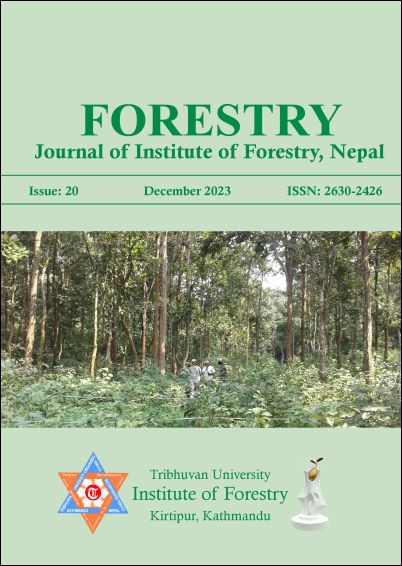Survival Status of Young Plants in Paluwatar Plantation Site of Udayapur District, Nepal
DOI:
https://doi.org/10.3126/forestry.v20i1.64278Keywords:
Plantation establishment, Tree survival assessment, Soil properties, Forest management, Restoration, Regeneration surveyAbstract
Forests provide multitude of benefits, including carbon sequestration, biodiversity conservation, timber production, and recreational opportunities. However, these valuable ecosystems are facing severe threats due to deforestation and land degradation. To counter this, plantation has emerged as a key strategy to restore degraded lands and ensure a continuous supply of ecosystem services. Yet, the success of these plantation sites remains uncertain due to a lack of systematic assessment of their survival status. Therefore, this study focuses on evaluating the survival status of young plantations on degraded riverbanks in Udayapur District, Nepal. Through systematic sampling at 0.5% intensity, 30 plots, each spanning 25 m², were established for regeneration inventory. Soil samples were collected using soil augers to a depth of 30cm for nutrient analysis. Nitrogen (N), Phosphorus (P), and Potassium (K) levels were determined using soil testing kits, while organic matter (OM) content was assessed using the Loss-on-Ignition (LOI) method. The results revealed an encouraging overall seedling survival rate of 95% at the research site. Notably, Dalbergia sissoo (Sissoo) and Tectona grandis (Teak) exhibited the highest survival rates at 100%, whereas Phyllanthus emblica (Amala) and Delonix regia (Gulmohar) showed lower survival rates at 40%. The site demonstrated low levels of N, P, and K, alongside high organic matter content. Unexpected high survival rate (95%) despite presence of a low level of nutrients raises intriguing questions about the adaptive mechanisms of the planted tree species. Further replication of similar studies as well as investigation of factors playing crucial role in seedling survival and growth beyond soil nutrient status is recommended.
Downloads
Downloads
Published
How to Cite
Issue
Section
License
© Tribhuvan University, Institute of Forestry




